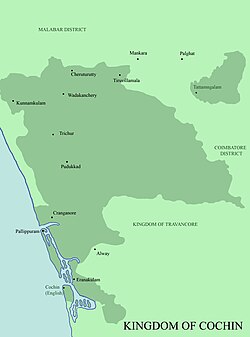
Back کوچین شاهلیغی AZB Cochin Catalan Cochin (Staat) German Reino de Cochín Spanish پادشاهی کوچین Persian Cochinin kuningaskunta Finnish État de Cochin French Kerajaan Cochin ID Regno di Cochin Italian コーチン王国 Japanese
This article has multiple issues. Please help improve it or discuss these issues on the talk page. (Learn how and when to remove these messages)
|
Kingdom of Cochin Kochi Rajyam | |||||||||
|---|---|---|---|---|---|---|---|---|---|
| 12th century CE[1]–1 July 1949 | |||||||||
|
Flag | |||||||||
 | |||||||||
| Status |
| ||||||||
| Capital | Perumpadappu Ponnani Kodungallur Thripunithura Thrissur Mattancherry | ||||||||
| Common languages | Malayalam | ||||||||
| Religion | Majority: Hinduism (official) Minority: Christianity Judaism Islam | ||||||||
| Government | Absolute monarchy Princely state | ||||||||
| Raja | |||||||||
• 12th century CE (first) | Veera Kerala Varma | ||||||||
• 1948–1949 (last) | Rama Varma XVIII | ||||||||
| Diwan | |||||||||
• 1812–1818 (first) | John Munro | ||||||||
• 1944–1947 (last) | C. P. Karunakara Menon | ||||||||
| History | |||||||||
• Established | 12th century CE[1] | ||||||||
• Disestablished | 1 July 1949 | ||||||||
| GDP (PPP) | estimate | ||||||||
• Total | 600.03 crores USD | ||||||||
| Currency | Rupee and Other Local Currencies | ||||||||
| |||||||||
| Today part of | India | ||||||||
The Kingdom of Cochin or the Cochin State, named after its capital in the city of Kochi (Cochin), was a kingdom in the central part of present-day Kerala state. It originated in the early part of the 12th century and continued to rule until its accession to the Dominion of India in 1949.
Historically, the capital of Cochin was in Kodungallur (Cranganore), but in 1341, the capital was moved to Cochin to remedy a disastrous flood. By the early 15th century, Cochin lost its ability to fully defend itself. By the late 15th century, the kingdom had shrunk to its minimal extent as a result of invasions by the Zamorin of Calicut.
When Portuguese armadas arrived in India, the kingdom of Cochin had lost its vassals to the Zamorins, including Edapalli and Cranganore, the later of which had even been at the centre of the kingdom historically. Cochin was looking for an opportunity to preserve its independence, which was at risk. King Unni Goda Varma warmly welcomed Pedro Álvares Cabral on 24 December 1500 and negotiated a treaty of alliance between Portugal and the Cochin kingdom, directed against the Zamorin of Calicut. A number of forts were built in the area and controlled by the Portuguese East Indies, the most important of which was Fort Manuel. Cochin became a long-term Portuguese protectorate (1503–1663) providing assistance against native and foreign powers in India. After the Luso-Dutch War, the Dutch East India Company (1663–1795) was an ally of Cochin. That was followed by the British East India Company (1795–1858, confirmed on 6 May 1809) after the Anglo-Dutch War, with British paramountcy over the Cochin state.

The kingdom of Travancore merged with the kingdom of Cochin to form the state of Travancore-Cochin in 1950. The five Tamil-majority taluks of Vilavancode, Kalkulam, Thovalai, Agastheeswaram, and Sengottai were transferred from Travancore-Cochin to Madras State in 1956.[2] The Malayalam-speaking regions of Travancore-Cochin merged with the Malabar District (excluding Laccadive and Minicoy Islands) and the Kasaragod taluk of South Canara district in Madras State to form the modern Malayalam-state of Kerala on 1 November 1956, according to the States Reorganisation Act, 1956 of the Government of India.[2]
The kingdom of Cochin, originally known as Perumpadappu Swarupam, was under the rule of the Later Cheras in the Middle Ages. After the fall of the Mahodayapuram Cheras in the 12th century, along with numerous other provinces Perumpadappu Swarupam became a free political entity. However, it was only after the arrival of Portuguese on the Malabar Coast that the Perumpadappu Swarupam acquires any political importance. Perumpadappu rulers had family relationships with the Nambudiri rulers of Edappally. After the transfer of Kochi and Vypin from the Edappally rulers to the Perumpadappu rulers, the latter came to be known as kings of Kochi.
